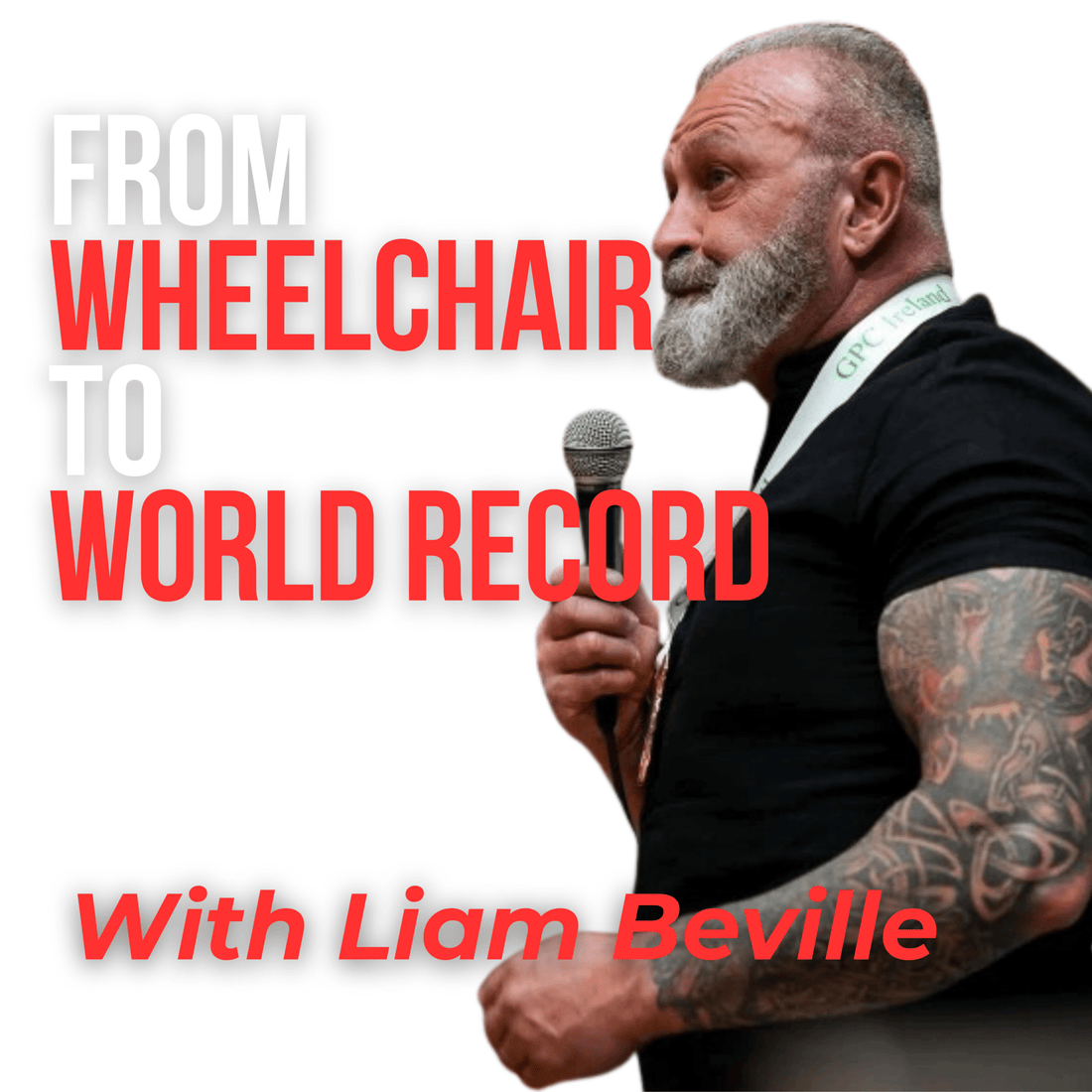
From Wheelchair to World Record: The Liam Beville Story
Share
At eighteen, Liam Beville was told he’d never walk again. A stolen car mounted a curb in Limerick and shattered both legs; bones protruded, life derailed, prognosis grim. He refused it. From wheelchair to crutches to platform, Liam rebuilt himself and, decades later, deadlifted 285 kg to claim a Guinness World Record — then kept going at sixty. This long-form feature — drawn from Liam’s conversation with Sam Penny on Why’d You Think You Could Do That? — traces the arc from catastrophe to comeback, and the mindset that turned pain into power.
It’s not about lifting weights. It’s about lifting yourself.
By Sam Penny · · Read time: ~16–18 minutes
Watch the Interview



A Tough Home, A Quiet Kid — Foundations of Fight
Liam grew up in Thomondgate on Limerick’s north side, the youngest of seven in a family doing it hard but holding tight. Two siblings had Down syndrome; one sister lived with severe autism and was non-verbal. Resources were scarce; love wasn’t. He learned early that attention wasn’t guaranteed and that competition could start at the dinner table. The trait that stuck? Stubbornness — the kind that becomes steel when life tests it.
June 1983 — The Night Everything Broke
On 3 June 1983, after a night out, a stolen car came “out of nowhere,” revving hard, mounting the curb. Liam shoved his mate left and leapt right. The impact obliterated both legs; bone pierced skin; the pain was indescribable. In the ambulance, fading in and out, he grabbed a collar and begged them not to take the leg. In hospital, doctors warned amputation was still possible.
He spent weeks in casts up to the hips; bones “disintegrated” in places meant plates were impossible. Survival became the full-time job.
Crutches to Iron — The Grind of Rebuilding
He started walking to a basement gym on underarm crutches, legs still like sticks under heavy bandage. Upper body responded first — shoulders, chest, triceps from hauling himself everywhere — while he coaxed a bend back into deadened knees. He’d sit on a bench, work shoulders, and inch the knee inward a little more each session. It wasn’t glamorous; it was survival disguised as training.
First Competition — Hooked by the Crowd
A local push–pull (bench + deadlift) meet arrived three years after the accident. No squats — his legs weren’t ready. He benched 100 kg and deadlifted 190 kg, out-lifting bigger, uninjured men. The crowd roared, oblivious to his history. He was hooked: “I’ll try the next one… I’ll keep going… I’ll get better.”
1992: 310 kg at 75 kg — The Lift That Wouldn’t Let Go
At the Celtic Nations, under IPF standards and three international referees, Liam pulled 310 kg at 75 kg bodyweight — an Irish and Celtic record that equalled the British mark. He still lost the overall to a brilliant squatter–bencher, and he went home dejected despite producing what remains one of the greatest Irish deadlifts ever recorded.
Depression, Perfectionism & the Poem That Helped
The price of relentless standards was familiar darkness. He talks frankly about depression — the dips without obvious trigger, the old culture of “toughen up,” and the learned habit of sitting with it instead of denying it. Kipling’s If became a compass: treat triumph and disaster as imposters, carry on either way.
That stoicism didn’t blunt ambition; it stabilised it. He learned to move without the need to glow after wins or collapse after losses.
Hypnosis, Visualisation & Returning to Form
After a long retirement, he planned a comeback across four federations and four weight classes — a moonshot sparked, oddly enough, by a stats site that wouldn’t accept his historic lifts without corroboration. Anxiety spiked in early qualifiers. So he tried hypnosis — not swinging watches, but mindset drills: visualising the crowd, the chalk, the pull, the medal. The work switched joy back on and smoothed the nerves enough to execute.
Guinness World Record at 57 — Oldest, Lightest, Still Rising
In his late fifties, he set the Guinness World Record for the heaviest disabled deadlift at 285 kg, weighing 86 kg. Guinness doesn’t recognise weight classes or age; it recognises the heaviest. Liam is both the oldest and the lightest person to have held that title — and he won “Best Lifter” at that able-bodied meet.
Asked what he felt when breaking a record, he says the first sensation is relief, followed by a peace he now allows himself to feel. Younger Liam would not have paused to smell the roses. Older Liam does — then gets back to work.
“Different Ability” — Why He Chose Able-Bodied Platforms
Growing up alongside siblings with disabilities shaped his insistence on inclusion. He refused to be labelled or siloed and deliberately competed among able-bodied athletes to ensure his achievements couldn’t be politely discounted. It wasn’t a dismissal of para-sport; it was a protest against the quiet condescension of low expectations.
Liam’s Playbook: 10 Moves You Can Use This Week
- Refuse the prognosis. Expert opinions are data, not destiny. File them; don’t surrender to them.
- Win the next metre. If the big goal is overwhelming, bend one knee another five degrees today. Repeat tomorrow.
- Name the darkness. Sit with low days; don’t pretend them away. They pass faster when you stop wrestling them.
- Compete to belong. Train where the standard is highest; let the room strain you into a better shape.
- Use pictures in the mind. Rehearse the lift, the meeting, the speech. Visuals are reps you can do anywhere.
- Detach from outcomes. Smell the roses; then move on. Treat victory and failure alike.
- Mind your company. Spend time with supporters; document and escalate bullies. Self-respect compounds.
- Let pain teach. Pain signals boundaries; it also signals life. Learn which kind to lean into and which to heed.
- Return to beginner. If you’ve been away for years, assume rust. Build capacity before you chase numbers.
- Be ageless. Remove the mirrors; add the miles. Age is a data point, not a verdict.
The Brave Five: Quickfire
Most unexpected lesson from recovery? Depression can be a teacher — grounding a mind that floats toward big dreams.
First emotion when he saw the Guinness certificate? Vindication — proof that decades of pain had purpose.
One thing he wishes he knew at eighteen? Don’t be a people-pleaser; friends can be fickle — protect your future self.
Mindset that mattered most? Stubborn, tunnel-visioned commitment — 100% or nothing.
When did he need bravery the most? In the ordinary grind: basement stairs on crutches, another careful bend of a damaged knee.
Listen, Subscribe & Explore the Guest Hub
Watch the full conversation above, listen on your favourite platform, and explore more quotes, resources, and links on Liam’s Guest Hub.

1 comment
Unbelievable achievement well done liam we should all take a leave out of his book 💪💪💪💪💪